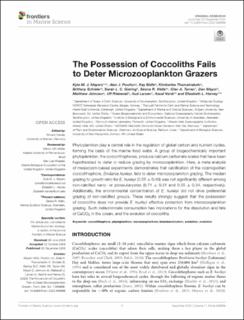| dc.contributor.author | Mayers, Kyle | |
| dc.contributor.author | Poulton, Alex J. | |
| dc.contributor.author | Bidle, Kay D. | |
| dc.contributor.author | Thamatrakoln, Kimberlee | |
| dc.contributor.author | Schieler, Brittany | |
| dc.contributor.author | Giering, Sarah L.C. | |
| dc.contributor.author | Wells, Seona R. | |
| dc.contributor.author | Tarran, Glen A. | |
| dc.contributor.author | Mayor, Dan | |
| dc.contributor.author | Johnson, Matthew | |
| dc.contributor.author | Riebesell, Ulf | |
| dc.contributor.author | Larsen, Aud | |
| dc.contributor.author | Vardi, Assaf | |
| dc.contributor.author | Harvey, Elizabeth L. | |
| dc.date.accessioned | 2023-09-20T06:55:16Z | |
| dc.date.available | 2023-09-20T06:55:16Z | |
| dc.date.created | 2021-02-04T13:42:54Z | |
| dc.date.issued | 2020 | |
| dc.identifier.issn | 2296-7745 | |
| dc.identifier.uri | https://hdl.handle.net/11250/3090637 | |
| dc.description.abstract | Phytoplankton play a central role in the regulation of global carbon and nutrient cycles, forming the basis of the marine food webs. A group of biogeochemically important phytoplankton, the coccolithophores, produce calcium carbonate scales that have been hypothesized to deter or reduce grazing by microzooplankton. Here, a meta-analysis of mesocosm-based experiments demonstrates that calcification of the cosmopolitan coccolithophore, Emiliania huxleyi, fails to deter microzooplankton grazing. The median grazing to growth ratio for E. huxleyi (0.56 ± 0.40) was not significantly different among non-calcified nano- or picoeukaryotes (0.71 ± 0.31 and 0.55 ± 0.34, respectively). Additionally, the environmental concentration of E. huxleyi did not drive preferential grazing of non-calcified groups. These results strongly suggest that the possession of coccoliths does not provide E. huxleyi effective protection from microzooplankton grazing. Such indiscriminate consumption has implications for the dissolution and fate of CaCO3 in the ocean, and the evolution of coccoliths. | en_US |
| dc.description.abstract | The Possession of Coccoliths Fails to Deter Microzooplankton Grazers | en_US |
| dc.language.iso | eng | en_US |
| dc.rights | Navngivelse 4.0 Internasjonal | * |
| dc.rights.uri | http://creativecommons.org/licenses/by/4.0/deed.no | * |
| dc.title | The Possession of Coccoliths Fails to Deter Microzooplankton Grazers | en_US |
| dc.title.alternative | The Possession of Coccoliths Fails to Deter Microzooplankton Grazers | en_US |
| dc.type | Peer reviewed | en_US |
| dc.type | Journal article | en_US |
| dc.rights.holder | © 2020 Mayers, Poulton, Bidle, Thamatrakoln, Schieler, Giering, Wells, Tarran, Mayor, Johnson, Riebesell, Larsen, Vardi and Harvey | en_US |
| dc.description.version | publishedVersion | en_US |
| cristin.ispublished | true | |
| cristin.fulltext | original | |
| cristin.qualitycode | 1 | |
| dc.identifier.doi | 10.3389/fmars.2020.569896 | |
| dc.identifier.cristin | 1886732 | |
| dc.source.journal | Frontiers in Marine Science | en_US |
| dc.relation.project | EC/H2020/731065 | en_US |
| dc.relation.project | National Science Foundation: OCE-1459200 | en_US |
| dc.relation.project | National Science Foundation: OCE-1657808 | en_US |
| dc.relation.project | National Science Foundation: OCE-1459190 | en_US |
| dc.relation.project | National Science Foundation: DBI-1624593 | en_US |
| dc.relation.project | Norges forskningsråd: 280414 | en_US |
| dc.relation.project | National Science Foundation: OCE-1537951 | en_US |

